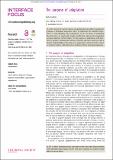Files in this item
The purpose of adaptation
Item metadata
| dc.contributor.author | Gardner, Andy | |
| dc.date.accessioned | 2017-08-22T09:30:29Z | |
| dc.date.available | 2017-08-22T09:30:29Z | |
| dc.date.issued | 2017-10-06 | |
| dc.identifier | 250153845 | |
| dc.identifier | d77b0284-aae3-4840-afa9-e77cfade9c63 | |
| dc.identifier | 85027846737 | |
| dc.identifier | 000407955600015 | |
| dc.identifier.citation | Gardner , A 2017 , ' The purpose of adaptation ' , Interface Focus , vol. 7 , no. 5 , 20170005 . https://doi.org/10.1098/rsfs.2017.0005 | en |
| dc.identifier.issn | 2042-8898 | |
| dc.identifier.uri | https://hdl.handle.net/10023/11524 | |
| dc.description.abstract | A central feature of Darwin’s theory of natural selection is that it explains the purpose of biological adaptation. Here, I: emphasise the scientific importance of understanding what adaptations are for, in terms of facilitating the derivation of empirically-testable predictions; discuss the population genetical basis for Darwin’s theory of the purpose of adaptation, with reference to the “fundamental theorem of natural selection”; and show that a deeper understanding of the purpose of adaptation is achieved in the context of social evolution, with reference to inclusive fitness and superorganisms. | |
| dc.format.extent | 7 | |
| dc.format.extent | 369202 | |
| dc.language.iso | eng | |
| dc.relation.ispartof | Interface Focus | en |
| dc.subject | Natural selection | en |
| dc.subject | Fundamental theorem | en |
| dc.subject | Darwinism | en |
| dc.subject | Inclusive fitness | en |
| dc.subject | Social evolution | en |
| dc.subject | Superorganism | en |
| dc.subject | QH301 Biology | en |
| dc.subject | QH426 Genetics | en |
| dc.subject | T-DAS | en |
| dc.subject.lcc | QH301 | en |
| dc.subject.lcc | QH426 | en |
| dc.title | The purpose of adaptation | en |
| dc.type | Journal article | en |
| dc.contributor.sponsor | NERC | en |
| dc.contributor.institution | University of St Andrews. School of Biology | en |
| dc.contributor.institution | University of St Andrews. Centre for Biological Diversity | en |
| dc.identifier.doi | 10.1098/rsfs.2017.0005 | |
| dc.description.status | Peer reviewed | en |
| dc.identifier.grantnumber | NE/K009524/1 | en |
This item appears in the following Collection(s)
Items in the St Andrews Research Repository are protected by copyright, with all rights reserved, unless otherwise indicated.

